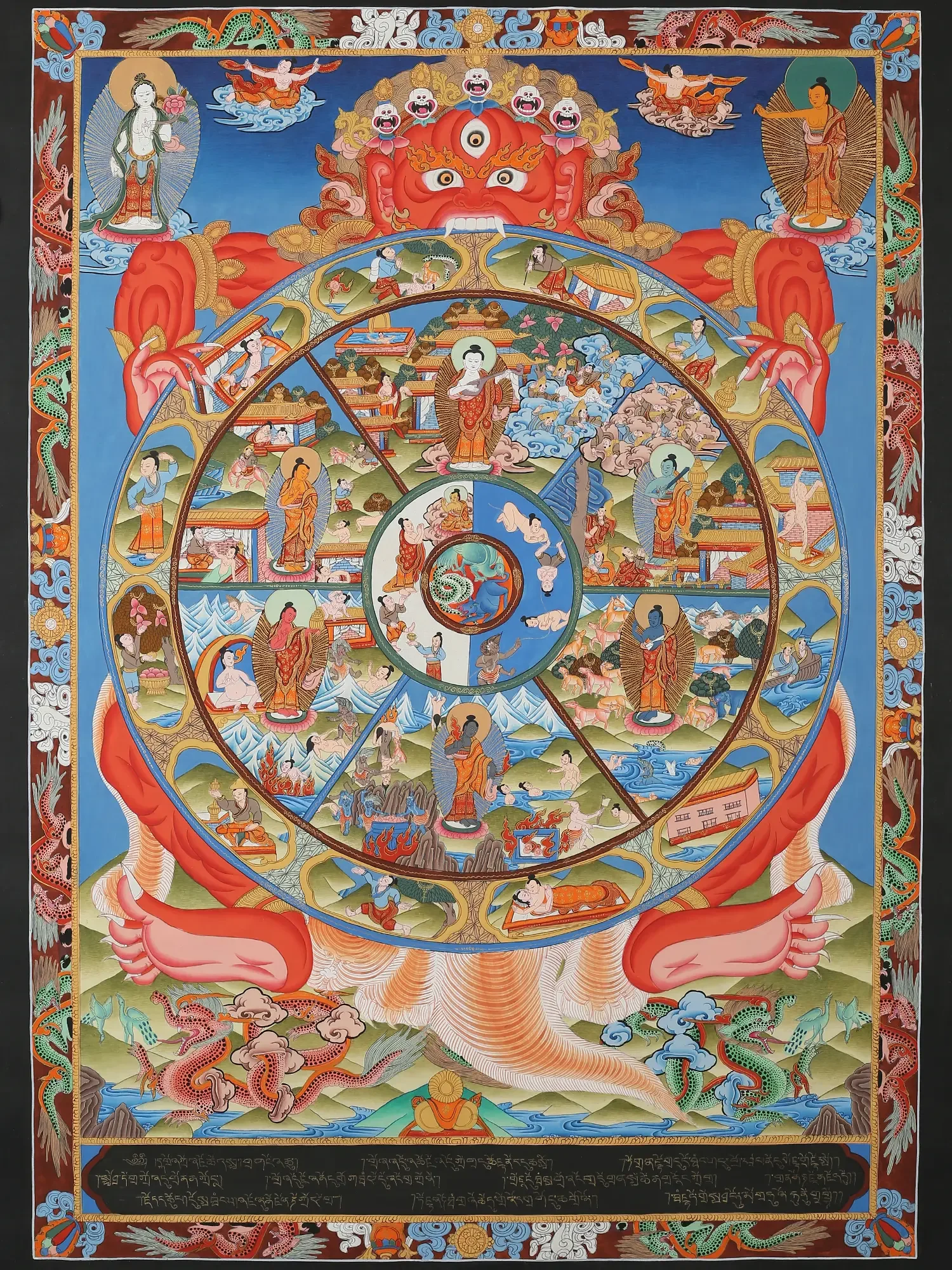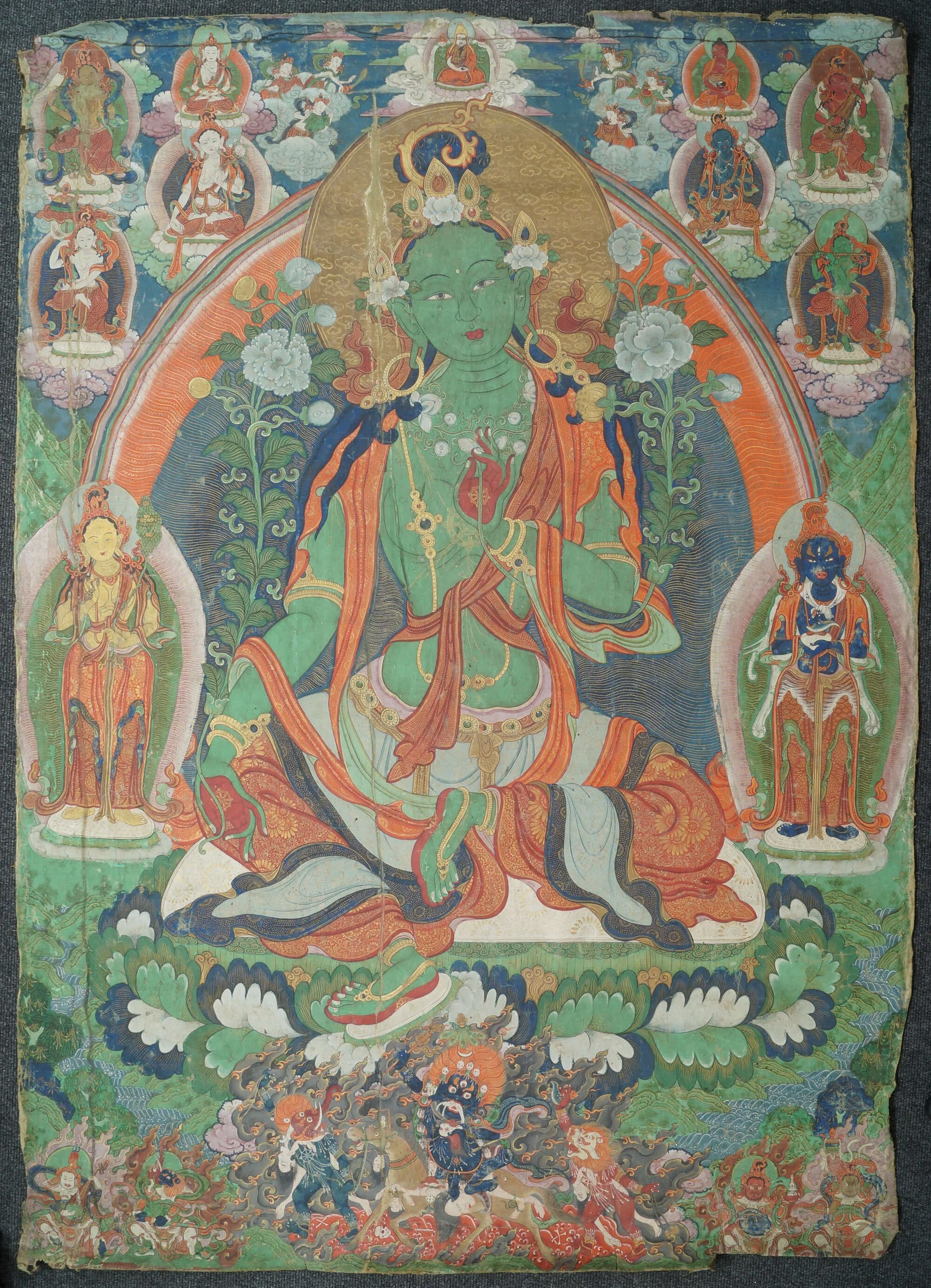More Than a Painting: The Three Evolutions of Tibetan Thangkas
Ever found yourself staring at a Tibetan Thangka painting? It can be a dazzling, almost overwhelming experience. You're faced with what feels like an "intimidating riot of heads, arms, and implements," all rendered in stunning, precise detail.
Chakrasamvara displaying a riot of heads, arms, and implements
It's easy to see this as beautiful, complex art. But what if it's more than that? What if it’s a sophisticated piece of spiritual technology?
The history of the Thangka is not a simple artistic timeline. It's a three-part journey that perfectly mirrors the evolution of Buddhist thought in Tibet. The art itself transformed from a diagnostic tool, to a devotional ideal, and finally, to a technology for enlightenment itself.
Here’s how it happened.
Stage 1: Art as a Diagnostic (The Problem)
The journey begins with an image that isn't even of a deity. As tradition holds, the Bhavachakra (Wheel of Existence) is arguably the single most important, and only, image commissioned by the historical Buddha, Siddhartha Gautama.
Bhavachakra (Wheel of Life) showing the six realms and the central figures
This isn't a picture to be worshipped. It’s a diagnostic tool.
It’s a map of samsara, the endless, suffering-driven cycle of rebirth. You could call it the "Time Trap" that defines the ordinary human condition. The figures in its six realms aren't gods; they are states of being (gods, demigods, humans, animals, hungry ghosts, and hell-beings) that we are all trapped in.
This art is purely pedagogical. It defines the problem, mirroring the first great shift in Buddhist thought: the goal of the Arhat, which is to understand this trap and escape it.
Stage 2: Art as Veneration (The Ideal)
The second phase, which marks the true birth of the Thangka as a devotional object, was kicked off by the "Second Spreading" of Buddhism in Tibet (around the 10th-12th centuries).
This era brought a second revolution in thought: the rise of the Bodhisattva. This is the heroic figure who, possessing an "incredible altruistic vow," seeks enlightenment not just for themselves, but for all beings.
This new, compassionate ideal required a new art, one focused on veneration. This shift was led by two key figures:
1) Lotsawa Rinchen Zangpo (958–1055): The "Great Translator," who, with his patron King Yeshe-Ö, imported master artists from Kashmir to decorate new temples in Western Tibet, like Tholing and Alchi. The stunning murals and sculptures they created of Avalokiteshvara (the Bodhisattva of Compassion) and Manjushri (Wisdom) became the "first draft" for this new ideal.
A peaceful Thangka of Avalokiteshvara
2) Atisha (982–1054): An Indian master who arrived in Tibet in 1042. He had a deep, personal devotion to Tara, the "mother of all Buddhas" who was mythologically born from the tears of Avalokiteshvara. Atisha popularized her practice, and the earliest Tara Thangkas show her as a swift, active savior from the "Eight Great Fears."
A Thangka of Green Tara depicted seated with one foot down, ready to act, holding a blue lotus
At this stage, the art has fundamentally shifted. It's no longer just a map of a problem, but a devotional image of a solution, an ideal to be venerated and prayed to.
Stage 3: Art as Technology (The Transformation)
This is the most radical and defining shift in Thangka art. It arrived with the "Third Revolution": the tantric path of the Siddha, or "magician."
This is Vajrayana Buddhism. This path is framed as a "shortcut" to enlightenment, and its "magic" is visualization. The goal is no longer to simply venerate the ideal but to become it, achieving enlightenment "lightning fast."
To do this, you need a blueprint. The Thangka was transformed into the primary technology for this practice: a "virtual presence," a "map" (Mandala), and a visual "algorithm" for profound internal transformation.
This revolution is where the art truly "explodes":
The Magicians: First, the art expanded to include the human masters who transmitted these potent teachings: Padmasambhava (Guru Rinpoche), the 8th-century master; Virupa, the Indian Siddha who could stop the sun; and Marpa Lotsawa, one of Tibet's great translators.
A Thangka of Padmasambhava (Guru Rinpoche) in his main form, shown holding a vajra and a skull cup, with a lotus hat.
The Secret Tools: These masters introduced the complex meditational deities (Yidams) and their fierce guardians. Drogmi Lotsawa brought the Hevajra Tantra from India, which became a central practice for the Sakya school. Marpa Lotsawa brought the lineages for Chakrasamvara, foundational to the Kagyu school. Fierce protectors like Mahakala ("Great Time") were introduced to guard these powerful, "secret" teachings.
A fierce Thangka of Six-Armed Mahakala
The Final Goal: The visual climax of this entire evolution is the Yab-Yum (father-mother) image. This is the "hieroglyph of non-duality," showing the central deity in sexual union with his consort. This isn't literal; it’s a visual algorithm for realizing the union of all seeming opposites: bliss and emptiness, compassion and wisdom, mind and matter. The practitioner, guided by the Thangka as a map, visualizes themselves as this non-dual union, transmuting the poisons of the "Time Trap" into the fuel of awakening.
A Thangka of Manjushri in union with consort (Yab-Yum), depicting the two figures in embrace, symbolizing non-duality.
From Prison Map to God Blueprint
The visual journey of Thangka art, from the Wheel of Life to the Yab-Yum image, is a complete and coherent map of the Tibetan path to enlightenment.
It’s the story of a civilization's art evolving in lockstep with its philosophy:
It moved from a diagram of a prison...
...to a portrait of a savior...
...and culminating in a blueprint for becoming a god.
The Thangka is not merely a painting. It is a "virtual presence" and a "map," a tool designed not just to be seen, but to awaken the mind that sees it.
A detailed Thangka of a Chakrasamvara Mandala.









